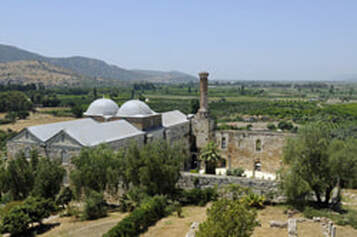Isa Bey MosqueArcheologists mention that there is a possibility of an Apollo temple in the place where the mosque was built. It was common in the ancient times to built an Apollo temple next to Artemis temple since they are considered as twins. Apollo was the twin brother of Artemis, the god of prophecy. The mosque was built in 1375 (According to Christian Calendar, According to moslem calendar 776) by the Architect Ali from Damascus, ordered by Isa Bey, The Emir Aydin. Has 2 parts as courtyard and the prayer room. Mosque was built with materials taken from former greco-roman buildings. Has 3 entrances. The west facade is made from the blocks of Marble from the cella of Artemision. In the center of the courtyard, there is a basin of octogonal shape for religious purifictions. It had 2 minarets. One was destroyed by an earthquake. Today it is the oldest active mosque in Turkey. It has been active since 14th century. In 1950s it was restored. Today only one out of two is standing.
Isa Bey Bath, the so-called Isa Bey Hamami is one of the most well-preserved baths from this period. An inscription kept in the Selcuk Museum and dated to 1364 refers to a Hamam which was erected during the rule of Isa Bey. Hardly anything remains of its originally magnificent appearance beyond the stuccoed wall decoration, partially with coloured paint and adjoined domes. Total of ten domes with partially very valuable stalactite decoration only five are preserved, while the main dome over the tepidarium is two-thirds collapsed. The water treatment took place further to the south, where the praefernium and the vaulted warm water basin are still preserved. The baths were later altered in the west by an additional building for women, a structure whose entrance was reached by a side passageway according to Islamic tradition. This resulted in partial alterations to the construction technique and the structure of the building. In the east of the baths, a row of nine premises have been revealed, which were oriented towards a narrow street and which can be interpreted as shops. Hamam II, an unnamed bathing complex, located to the west of the Isa Bey Cami in an area used for agricultural purposes. These ruins, which until recently functioned as stables, were first freed from the damaging effects of tree growth, cleaned, and then protected from further vandalism by the erection of a fence. This building is differentiated from the Isa Bey Hamam both in its ground-plan and in its fittings, and can be classed as younger on the basis of its building technique. View Larger Map- Isa Bey Mosque |
|

